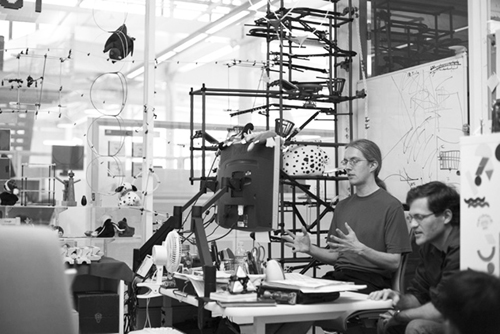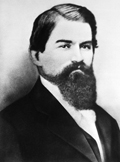How They Started (33 page)
Authors: David Lester

Following the buzz this created, Google experienced a major growth spurt. Larry and Sergey continued in their method of custom-building server racks using parts from low-cost PCs and stacking them one on top of the other, getting maximum value per square foot in their data centers. At this stage, their business model was to earn income by licensing their search technology to other partners. This wasn’t bringing in sufficient revenue, so they began to consider other ways to turn their growing search engine into a sustainable business.
They were initially hesitant to allow advertisers onto the site because they worried that users would doubt the search results’ impartiality, and Sergey and Larry remained resolute that they would never allow companies to pay to rank more highly, as other search engines had done. They came up with a compromise which was to revolutionize not only their own business, but also their competitors’—and the world’s advertising industry. Their idea was that whenever someone searched for a topic, they would display small text ads relevant to the subject of the search alongside the more prominent “natural search engine results.”
Sergey and Larry remained resolute that they would never allow companies to pay to rank more highly. … They came up with a compromise which was to revolutionize the world’s advertising industry.
This soon evolved into the current pay-per-click model, whereby Google would earn money whenever a user clicked on one of these “sponsored links.” The rate paid per click was set by the advertiser in a fair, automated online auction process.
This worked spectacularly well for several reasons: it was extremely simple and quick for an advertiser to set up; it could be tested for a tiny investment (far smaller than any other advertising method); it enabled advertisers to present their message to a very highly targeted audience; it was free unless someone clicked on the advertiser’s link; it was easy to measure how successful it was; and, above all, it worked. Advertisers got excellent results from people clicking on their ads.
In 2000, the founders hired Dr. Eric Schmidt as chief executive to take over the day-to-day running of the business. Although Sergey and Larry were hesitant at first for fear of losing control of the company they had created (after all, this was a condition of the investment to which they had reluctantly agreed) Schmidt’s appointment proved to be extremely successful. In particular, his business expertise played a key role in Google’s overseas expansion. One of the first things he noticed was that, while 60 percent of its searches came from outside the US, just 5 percent of ad revenues came from overseas advertisers. While the searches had been available in foreign languages for some time, and the business was truly serving a global audience, it had yet to make money from this. Under Schmidt’s supervision, sales offices were duly established in London, Hamburg, Tokyo and Toronto. Revenue soared.
Google’s stated mission is “to organize the world’s information and make it universally accessible and useful.” Hardly a modest ambition! As its revenue grew, it started adding new services to deliver more of this mission. By 2004, in addition to the core search engine, it offered Google Images, a huge library of searchable images, and Google News, a service that aggregated stories on any particular subject from around the world. It also introduced Gmail, a Web-based email service.
In August 2004, the founders reluctantly listed the search engine on the NASDAQ stock exchange, raising $1.2 billion. Going public was actually the last thing Sergey and Larry wanted to do. Apart from the fact that their independence had helped them weather the dot-com bust, they were extremely hesitant to make their financial information available to competitors.
Up until 2004, analysts had grossly underestimated just how big the search giant had become, and the last thing Google wanted was for the world to know how much money they were making, or more information on how they were making it. However, they now had so many investors that US law required them to disclose their financial information. Given that they would have to spill the beans anyway, they felt it prudent to take the company public and give their early employees and investors a tangible return.
No other company has created such phenomenal influence, profit and wealth in such a short time.
But shortly before its IPO, a number of factors coincided to bring down Google’s share price. First, the company had to deal with backlash from rival Overture, a subsidiary of its largest competitor, Yahoo! Overture pioneered the idea of selling ads to accompany search results using a pay-per-click model, and accused Google of infringing its patents. Conscious of the negative effect of the ongoing legal battle in the run up to its stock market debut, Google’s founders gave Yahoo! 2.7 million shares in an out-of-court settlement.
Secondly, Google’s recent entry into the email market with Gmail was steeped in controversy. The founders sought to offer a service that was far better than anything else out there. Using their search technology, you could easily search for and find a stored message within Gmail, and Google offered what was then a colossal one gigabyte of space with an account. However, their plans to make money through contextual ads, which were generated by scanning messages and matching ads to keywords, were slammed by privacy advocates.
The combination of factors meant that Google’s IPO valued shares at just $85 each. But this didn’t last for long. Despite these setbacks, Google’s share price rose to $100 by the end of the first day of trading, valuing the company at $23.1 billion. As with many new companies in Silicon Valley, many of Google’s early employees had been given share options (instead of high salaries, which helped keep costs down for the young business while it was trying to become profitable. This made early hires millionaires when the company went public.
Part of Google’s phenomenal growth has come from a scheme it created called AdSense. This allows other websites to install a Google search box on their site; when users click on the contextual ads that Google supplies, the partner website earns some of the fee advertisers pay to Google. AdSense has been enormously popular with other websites, including giants such as AOL and the
New York Times
. AdSense is typical of Google’s progressive approach and its belief that working alongside competitors can grow the market for all.
Google has used its success to make a number of significant acquisitions. Examples include its $1.65 billion purchase of user video clip phenomenon YouTube in October 2006 and its purchase of online advertising network Doubleclick in April 2007. The latter was bought for $3 billion, lengthening its reach into the display advertising market on the Web.
The company’s founding principles have also played a key part in the company’s success, not least the founders’ determination to make Google a great place to work. Its motto, “Don’t be evil,” is world famous, as is the award-winning culture that Sergey and Larry have fostered. On site at its Mountain View headquarters, staff can make use of a wide range of facilities, including pool tables, swimming pools and volleyball courts, as well as being well fed with free gourmet food.
Engineers are given 20 percent of their time whereby they are actively encouraged to work on their own projects. Both Google News and Froogle, an online shopping service, are the result of this initiative. Google now has sales offices all over the world, and this culture of creativity pervades them all. As a result, the company receives more than 1,300 job applications every week.
Its motto, “Don’t be evil”, is world famous, as is the award-winning culture that Sergey and Larry have fostered.
No other company in history has achieved such brand awareness without spending heavily on advertising and marketing. No other company has created such phenomenal influence, profit and wealth in such a short time.

Technicians hard at work in the Google office, in Mountain View, California.
Where are they now?
At the height of its success in 2007, shares in Google were being sold for $741.80, but its price began to tumble amid fears that its ad revenue was falling (newspapers reported fewer people were clicking on its ads). But, true to form, Google laid waste to those claims when it brought home $1.3 billion in profit between January and March 2008, on revenue of $5.1 billion.
In April 2011, a Google share would set you back $577. Its market capitalization (the current value of all its shares) at that time reached a staggering $185.6 billion. Annual revenues hit just shy of $30 billion for 2010, with net income of $8.5 billion for the period.
Google’s website now processes hundreds of millions of searches every day. Google’s homepage has retained its design simplicity, despite the fact that it could potentially be a source of considerable extra income. As a result, it loads quickly, improving the customer experience. Likewise, Google has steered clear of Flash features and other elements that would slow it down. It is estimated that Google’s network now consists of considerably more than 500,000 servers, a computing power unmatched by any other company. Its employees still assemble and customize the PCs the company uses to carry out its searches. No enterprise has more computing power than Google.
Sergey Brin and Larry Page moved to their Mountain View, California, headquarters in 2004, and that is where the company remains to this day.
From April 2011, Larry resumed his position as chief executive, with Eric Schmidt becoming executive chairman. Sergey, meanwhile, devotes his time to strategic projects and developing new products to solve great problems.

The Coke side of business
Founders:
John Pemberton (creator) (shown) and Asa Griggs Candler (business founder)
Age of founders:
55 and 35
Background:
Pharmaceuticals and sales
Founded in:
1886
Headquarters:
Atlanta, Georgia
Business type:
Beverage manufacturer

Everyone has sampled the “Coke side of life.”
Its trademark scripted, bright red logo can be seen all over the world—from English pub umbrellas to football stadiums, from Chinese shop signs to a 20-foot-tall neon sign in Times Square. It’s no exaggeration to say that The Coca-Cola Company has a presence in every country in the world, and arguably it was the world’s first truly global brand. It has been declared both the world’s most recognizable trademark and the world’s most popular branded drink.
Yet this amazing success story had very humble beginnings. A pharmacist from Atlanta named John Pemberton invented a new “medicine” called Coca-Cola. One afternoon in 1886, when workers were building the Statue of Liberty in New York Harbor, John was experimenting in his backyard with combinations of ingredients in a three-legged brass pot to try to develop a new medicine. He came up with a fragrant, caramel-colored liquid. Out of sheer curiosity, he took it to neighboring Jacobs’ Pharmacy, where he added carbonated water. After testing it on customers, who all thought it was something special, Jacobs’ Pharmacy started selling it as a medicine for 5 cents a glass (the equivalent of about a dollar today). John claimed his new drink cured diseases, including morphine addiction, dyspepsia, neurasthenia, headache, and even impotence.
